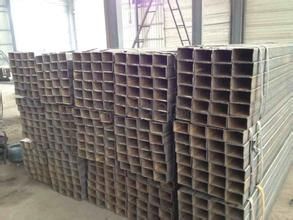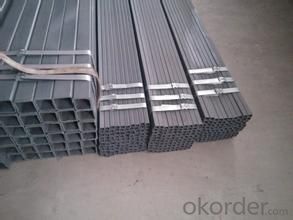Suare High Quality Steel Pipe
- Loading Port:
- China Main Port
- Payment Terms:
- TT or LC
- Min Order Qty:
- 25-35 watt
- Supply Capability:
- -
OKorder Service Pledge
OKorder Financial Service
You Might Also Like
Quick Details
| Thickness: | 0.45 - 2.5 mm | Section Shape: | Square | Place of Origin: | Hebei China (Mainland) |
| Secondary Or Not: | Non-secondary | Application: | furniture pipe. fence tube,structure pipe etc.,handle railings.fence tube,shelves, furniture, threading tube | Technique: | Cold Rolled |
| Certification: | 50x50mm square pipe | Surface Treatment: | pre-galvanzied,black,pre-galvanized,black annealed | Alloy Or Not: | Non-alloy |
| Material: | Q195,Q215,Q235 | Technology: | Colled rolled | Wall thickness: | 0.45mm-2.5mm |
| Length: | 4.5m~7m | Lenght tolerance: | +/-20mm | OD tolerance: | +/-0.5mm |
| Thickness tolerance: | +/-0.03mm | Grade: | Q235,Q195,Q215,Q195-Q345 | Standard: | GB/T3901,GB,GB/T 3091-2008 |
Packaging & Delivery
| Packaging Detail: | in bulk, in small bundle or as customer's request |
| Delivery Detail: | about 10 days after receiving customer's deposit |
Specifications
square steel pipe :
Material: Q195,Q215,Q235
Surface: pre-galvanized,black
Wall thickness: 0.45mm-2.5
Square Pipe Image


FAQ of Square Pipe
①How is the quality of your products?
Our products are manufactured strictly according to national and internaional standard, and we take a test
on every pipe before delivered out. If you want see our quality certifications and all kinds of testing report, please just ask us for it.
Guaranteed: If products’ quality don’t accord to discription as we give or the promise before you place order, we promise 100% refund.
②How about price?
Yes, we are factory and be able to give you lowest price below market one, and we have a policy that “ for saving time and absolutely honest business attitude, we quote as lowest as possible for any customer, and discount can be given according to quantity”,if you like bargain and factory price is not low enough as you think, just don’t waste your time.Please trust the quotation we would give you, it is professional one.
③Why should you chose us?
Chose happens because of quality, then price, We can give you both.Additionally, we can also offer professional products inquiry, products knowledge train(for agents), smooth goods delivery, exellent customer solution proposals.Our service formula: good quality+good price+good service=customer’s trust
SGS test is available, customer inspection before shipping is welcome, third party inspection is no problem.
Any question, pls feel free to contact us !
- Q:Heating system DN40 and DN32 welded steel pipe how to connect?
- Welding: AC arc welding machine welding. Mode 1: apply to the medium of non demanding piping, DN40 steel pipe necking and DN32 steel pipe butt welding, or directly DN32 steel pipe into the DN40 internal welding. 2: the pipeline requirements apply to the inner wall of smooth transition, reducing short circuit welding for DN40x32 suppression of this mechanism are used for connection pipe seamless steel pipe high pressure pipeline connection, no special requirements, not commonly used welded steel pipe. Connection of mechanism fittings is not only costly, but not necessary unless special requirements are required!
- Q:What is the difference between steel pipe and polyethylene pipe?
- Steel pipe and polyethylene pipe are two different types of materials used for plumbing and construction purposes. The main difference between these two pipes lies in their composition and characteristics. Steel pipe is made from a combination of iron and carbon, which gives it its strength and durability. It is commonly used in applications where high pressure and heavy loads are expected, such as in industrial settings or for underground gas and oil pipelines. Steel pipe is known for its resistance to corrosion and its ability to withstand extreme temperatures. On the other hand, polyethylene pipe is a type of plastic pipe made from high-density polyethylene (HDPE) or low-density polyethylene (LDPE). It is lightweight, flexible, and easy to install, making it a popular choice for residential plumbing and irrigation systems. Polyethylene pipe is resistant to chemicals, UV rays, and abrasive materials, making it suitable for both above-ground and underground installations. Another significant difference between steel pipe and polyethylene pipe is their cost. Steel pipe generally tends to be more expensive due to the raw materials and manufacturing processes involved. Polyethylene pipe, on the other hand, is relatively affordable and cost-effective, especially for smaller-scale projects. In terms of maintenance, steel pipe requires periodic inspections and maintenance to prevent corrosion and ensure its longevity. Polyethylene pipe, on the other hand, is virtually maintenance-free due to its resistance to corrosion and chemical degradation. In summary, the main difference between steel pipe and polyethylene pipe lies in their composition, strength, durability, cost, and maintenance requirements. The choice between these two pipes depends on the specific needs of the project, taking into consideration factors such as pressure, load, budget, and environmental conditions.
- Q:Can steel pipes be used in the automotive industry?
- Yes, steel pipes can be used in the automotive industry. They are commonly used for various applications such as exhaust systems, fuel lines, and structural components due to their strength, durability, and resistance to heat and corrosion.
- Q:How are steel pipes used in offshore wind farms?
- Steel pipes are used in offshore wind farms for various purposes such as the installation of turbine foundations, transmission of electricity from the turbines to the shore, and protection of underwater cables. These pipes provide structural support, corrosion resistance, and durability in the harsh marine environment, enabling the efficient and reliable operation of offshore wind farms.
- Q:What are the advantages of using stainless steel pipes?
- There are several advantages of using stainless steel pipes. Firstly, stainless steel is highly resistant to corrosion, making it suitable for various applications where exposure to moisture or harsh environments is a concern. Secondly, stainless steel pipes have excellent strength and durability, allowing them to withstand high pressures and temperature fluctuations. Additionally, stainless steel is hygienic and easy to clean, making it ideal for applications in the food and beverage industry. Lastly, stainless steel pipes are aesthetically pleasing and can be easily integrated into different architectural designs.
- Q:How do you calculate the flow velocity in a steel pipe?
- In order to determine the flow velocity in a steel pipe, one must take into account the principles of fluid mechanics and apply relevant equations. The Bernoulli equation is the most commonly used equation for this purpose, as it establishes a relationship between the pressure, velocity, and elevation of a fluid. The first step is to ascertain the volumetric flow rate (Q) of the fluid that passes through the pipe. This can be achieved either by measuring the mass flow rate (m) or by directly measuring the volumetric flow rate using a flow meter. Once the volumetric flow rate is obtained, the flow velocity (V) can be calculated. To calculate the flow velocity (V), divide the volumetric flow rate (Q) by the cross-sectional area (A) of the pipe. The cross-sectional area of the pipe can be determined using the formula A = πr^2, where r represents the radius of the pipe. Hence, the formula to calculate the flow velocity (V) in a steel pipe is: V = Q / A It is important to note that this calculation assumes an ideal flow condition and does not take into account any frictional losses or other factors that could impact the flow. In real-world scenarios, it is crucial to consider additional factors such as pipe roughness, fluid viscosity, and pipe diameter to obtain a more accurate estimation of the flow velocity.
- Q:What are the common sizes of steel pipe fittings?
- The common sizes of steel pipe fittings range from 1/8 inch to 24 inches in diameter.
- Q:How do you calculate the pipe pressure drop coefficient for steel pipes?
- To calculate the pipe pressure drop coefficient for steel pipes, you can use the Darcy-Weisbach equation, which takes into account factors such as the pipe length, diameter, roughness, and fluid flow rate. The coefficient can be determined using empirical correlations or charts based on these parameters, ensuring accurate estimation of pressure drop in steel pipes.
- Q:What time what time for gas pipeline steel pipe PE pipe
- City network is generally medium, are generally. PE pipe high pressure pipe with building the required distance, is generally used around the high pressure pipe laying (high pressure gas supply capacity, and can play the role of peak shaving), the city zone by the supply voltage to the voltage, residential building regulation boxes of low voltage supply to the users.
- Q:Can steel pipes be used in the oil and gas industry?
- Yes, steel pipes are commonly used in the oil and gas industry. They are known for their high strength, durability, and resistance to corrosion and high pressure, making them suitable for transporting oil and gas.
1. Manufacturer Overview |
|
|---|---|
| Location | |
| Year Established | |
| Annual Output Value | |
| Main Markets | |
| Company Certifications | |
2. Manufacturer Certificates |
|
|---|---|
| a) Certification Name | |
| Range | |
| Reference | |
| Validity Period | |
3. Manufacturer Capability |
|
|---|---|
| a)Trade Capacity | |
| Nearest Port | |
| Export Percentage | |
| No.of Employees in Trade Department | |
| Language Spoken: | |
| b)Factory Information | |
| Factory Size: | |
| No. of Production Lines | |
| Contract Manufacturing | |
| Product Price Range | |
Send your message to us
Suare High Quality Steel Pipe
- Loading Port:
- China Main Port
- Payment Terms:
- TT or LC
- Min Order Qty:
- 25-35 watt
- Supply Capability:
- -
OKorder Service Pledge
OKorder Financial Service
Similar products
New products
Hot products
Related keywords





























